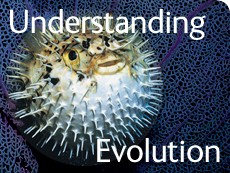What's in a name? A history of taxonomy
By Sandra Knapp
The Darwinian revolution

Charles Darwin (1809-82).
Taxonomy became more complicated towards the end of the eighteenth century with the discovery of a multitude of species in the tropics. Around this time scientists were realising that it wasn't enough to simply name species--it was also important to try to elucidate the relationships between them.
Early depictors of relationships produced diagrams that looked like road maps, with a beginning and an end, to represent the relationships between different species. They were essentially constructed as scales or ladders, and human beings were always at the top of the scale. It was really a two-dimensional view of nature, a place for everything and everything in its place. But at this time scientists were also starting to wonder about the how of biological diversity.
Darwin and the Galapagos finches
In the 1830s Charles Darwin embarked on the voyage of the Beagle with Captain Fitzroy, as a gentleman naturalist. They travelled around the continent of South America, stopping and collecting specimens along the way. They went to the Galapagos Islands where Darwin collected many organisms, among them the birds, which would come to be known as Darwin's finches. Throughout the voyage, Darwin observed the world around him and formulated questions as to how it had all come about. When he returned to England and settled back into the scientific establishment he started working towards the answer.
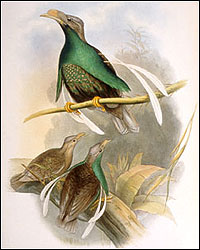
Wallace's Standard wing Bird of Paradise, Semioptera wallaceii, discovered by Alfred Russel Wallace in South east Asia and named after him.
About 20 years later another young Englishman, Alfred Russel Wallace, went with his beetle-collecting friend Henry Walter Bates on a collecting venture to South America. He spent four years there collecting specimens, mostly birds and butterflies, to sell to avid collectors of natural history objects back in London. The collection was embargoed by customs for some time but this was only the start of Wallace's trouble. Once he had finally booked passage and the ship set sail on the way back to England, disaster struck. Halfway across the Atlantic it caught on fire and sank, along with the entire collection. Wallace lost absolutely everything--four years of hard work and substantial financial investment. Remarkably, instead of giving up as lesser men might have done, Wallace recovered from this blow and set off on a new expedition, this time to the Malay Archipelago in South East Asia. He collected butterflies and birds of paradise, animals for which there was a huge market in England, particularly in London. The Victorians were fascinated by all sorts of exotica, and by natural history in general; unusual specimens and rare species could fetch a high price in the London auction houses.
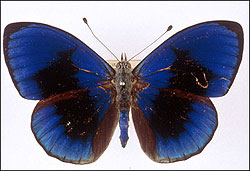
This specimen of the butterfly Asterope sapphira was collected by Henry Walter Bates, the travelling companion of Alfred Russel Wallace, in the Amazon in the 1850s.
Wallace wrote a letter to Darwin from the island of Ternate, off the coast of what is today called Sulawesi, outlining a theory that he'd been developing, about the origin of species and the nature of organic change. Darwin was astonished--Wallace was describing the same natural system that he had been contemplating for 20 years, but had never had the nerve to publish.
Two papers outlining the theory of the origin of species and evolution by natural selection were read, in the absence of both men, at the Linnean Society of London. Wallace was still in Asia and Darwin lived a reclusive life in Kent. The theory they independently articulated was to completely change the way people think about the world around them, and also the way that taxonomists work. The two dimensional road map design of relationships between organisms was replaced by Darwinian ideas of ancestors and descendants.
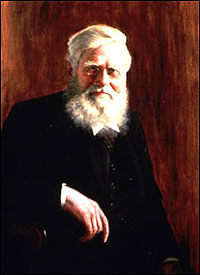
Alfred Russel Wallace (1823-1913).
Darwin went on to write The Origin of Species, a book with many words (still considered by Darwin to be only a synopsis of his theory!) but only one picture. This image depicts how, through time, new species arise and existing species go extinct. A key factor that Darwin introduced to the study of taxonomy was the time dimension. For the first time, scientists realised that the Earth's complement of species was not the same one that had always existed, but that the story was much more complicated. So because of Darwin's ideas, taxonomy went from being a finite to an infinite science. Taxonomy no longer represented the task of listing all the species that came into being at the time of the Creation but instead became a completely different sort of discipline, one that knew no bounds--a prospect both exciting and a little scary.
Homology and ancestry
Darwin pushed along the transformation of a central biological concept, that of homology. Before Darwin, homology, or sameness, referred to structural or functional similarity. After Darwin, homology came to define two or more organisms that are structurally the same, and derived from a common ancestor. This is the current usage of the word in systematics and taxonomy. So Darwin's theory of evolution by natural selection brought the ancestry theme to homology.
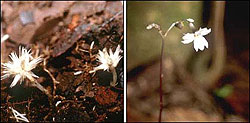
Voyriella (left) and Burmannia (right) from the forests of Central America.
It is easy to assume that homology is relatively trivial and simple to determine. But it's often extremely difficult to know whether two organisms are homologous or not. For example, both birds and butterflies have wings but, because birds and butterfflies are not closely related, it's clear that they are not homologous structures. Although they have the same function and both allow their organism to fly they are not derived from the same anatomical structure. A bird's wing has bones in it, a butterfly's do not--they are non-homologous structures. They do of course have a common ancestor, as all living organisms do, but they do not have a close one. Other homology relationships are harder to determine.
Homologous characters?
Voyriella is a tiny species belonging to the gentian family, which grows in the forest of Central America, is a saprophyte and does not contain any chlorophyll. Another plant occurring in the same forests, Burmannia of the family Burmanniaceae, similarly does not contain any chlorophyll. Is this character homologous? Since it is known that these two plants do not share a close common ancestor, it can be extrapolated that the character is not.
Two plants, both in the genus Solanum, Solanum triphyllum and Solanum tridynamum, both have very irregular anther shapes, giving them zygomorphic flowers, i.e. they have only one plane of symmetry. The stamens however are very subtly different in the two species, the irregularity in Solanum triphyllum is due to the two side stamens, while that of Solanum tridynamum is due to the lower stamen. Thus, irregularity of anthers in these two solanums cannot be interpreted as homologous, because it is due to different things. These two solanums share a closer common ancestor than do the two saprophytic plants, but it is essential for taxonomists to carefully analyse each character before coming to conclusions.
Determining homology is one of the taxonomist's main tasks. Patterns of homology generate hypotheses about relationships between species. Organisms' characters are analysed in order to determine whether or not they are homologous and can be used to determine relationships. It is of little utility to group organisms using only functional structures--we all know birds and butterflies are not related evolutionarily, but if we classified on ability to fly they would be grouped together.
Thinking point
The publication of The Origin of Species created a revolution in thinking, both for the scientific community and society as a whole. How hard do you think it was for people to refute the traditional dogma and accept a new explanation for life on Earth?
After Darwin and the development of evolutionary thought, relationships between organisms were represented on diagrams that resembled trees, rather than road maps. The German biologist Ernst Haeckel was one of the most imaginative creators of these tree diagrams. One of the problems with these metaphorical diagrams was that human beings were always seen as being on the top of the tree, the pinnacle of evolution, just like those road-map diagrams before the incorporation of the time dimension.
Toolbox

Last year nearly 100,000 specimens were loaned to scientific institutions and researchers worldwide.
